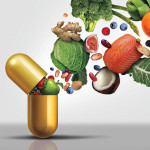For PWAs with limited resources, vitamin supplements can be out of the question,” says Lynde Francis, who gives nutrition advice to fellow HIVers at The Centre, a Zimbabwean ASO. “That makes concentrating dietary choices on nutrient-rich foods a must.” This prescription is backed by nutritionists and research in the United States. Francis recommends consuming as many of the traditional foods eaten by your ancestors as you can. Key are relatively unrefined grains rather than the highly denatured products—especially white sugar, white flour and white rice—that contribute little to health. (Read labels carefully—processed foods and “juice” drinks are laden with sugar in the form of dextrose, sucrose or corn syrup.) While the specifics will vary depending on your heritage, your location, your budget and the availability of items, Francis’ take-home message is the same whether you live in New York City or Namibia: “If your great grandmother didn’t eat it, you shouldn’t.” Francis divides foods into three categories and offers the following suggestions—both African and North American favorites—for healthy eating:
“Energy” foods keep your heart pumping, lungs breathing, glands functioning and legs moving. Included are whole grains, roots, beans and legumes, fruits and healthy fats. Keep total fat intake modest to avoid diarrhea. And try to skip partially hydrogenated fats (found in margarine, shortening and many cooking oils and baked goods), since they increase oxidative stress that damages the body.
“Constructive” foods build, repair and maintain the body, provide the ingredients for immune function and help to keep the nervous system healthy. To increase your body’s protein intake, include a variety of plant proteins—such as beans and legumes, nuts, seeds and whole grains—every day. Adding a small amount of animal-protein foods can help ensure the maximum protein boost from plant foods. Liver can be a particularly good source of vitamins that might otherwise be missing in limited diets, including the all-important B-12.
“Protective” foods provide the micronutrients—vitamins, minerals and the factors that work with them—plus fiber and fluids that are vital for healthy body functioning. These foods can help to boost your immune function and slow disease progression.
“Energy” and “constructive” foods also contain some of these health essentials, but fruits and vegetables are nature’s richest source of micronutrients, as well as of the soluble fiber that can help to prevent diarrhea. Get as many daily servings as possible of a wide variety of fruits (raw, cooked or dried) and vegetables. The more color in these foods, the better, since that’s usually where the nutrients are. And note that it’s important to eat the fruits and vegetables themselves, not just drink their juice: The juicing process removes many nutrients and most fiber. Using methods like steaming, baking or sautéing preserves more nutrients than boiling or deep frying.
Water, of course, is what life depends on, so downing plenty of fluids every day is a must. A good rule: Divide your body weight in pounds in half and drink that number of liquid ounces daily. A few cautions: If water quality is iffy, a combination of filtering and boiling can greatly reduce the risk of water-borne infections. If diarrhea is causing excessive fluid loss, increase your liquid intake. Last but not least, caffeine and alcohol drain fluids from the body, so even if your grandma was a boozer, that’s no excuse—avoid them to the extent that you can, and be sure to tank up on extra water when you do indulge.
Whole grains
(including breads, cereals, pastas and crackers)
Corn or maize
Rice
Oats
Wheat
Rye
Barley
Millet
Sorghum
Healthy fats
(use in moderation)
Nuts
Seeds
Peanuts
Peanut oil
Olive oil
Palm tree oil
Shea tree butter
Butter
Meat fats
Fruits
Oranges
Bananas
Plantains
Papayas
Mangoes
Tomatoes
Berries
Watermelons
Mangoes
Apricots
Roots
Potatoes
Yams
Manioc
Taro
Beans and legumes
Beans (all types)
Lentils
Split peas
Peanuts
Animal-protein foods
Eggs
Red meat
Organ meats (including liver)
Fish and other seafood
Poultry
Dairy products
Vegetables
Carrots
Squashes
Okra
Gombo
Broccoli
Green beans
Peas
Green, leafy
Vegetables

Thinkstock
Grandma’s Recipe
It sounds retro, but respect for tradition is healthy.






Comments
Comments